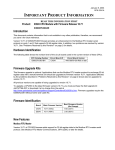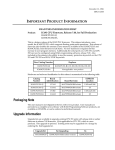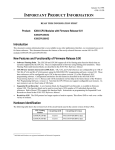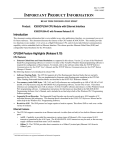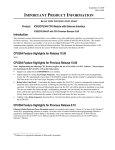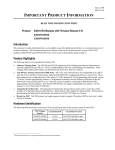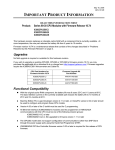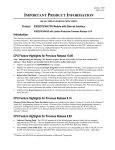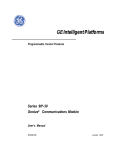Download Series 90-30 CPU Release, IC693CPU352-EK, 363-BE GFK
Transcript
May 10, 2010 GFK-1126AG IMPORTANT PRODUCT INFORMATION READ THIS INFORMATION FIRST Product: IC693 CPU Modules IC693CPU352-EK with Firmware Release 10.50 IC693CPU363-BE with Firmware Release 10.50 Introduction This document contains information that is not available in any other publication; therefore, we recommend you save it for future reference. This version of the CPU352 module (IC693CPU352-EK) incorporates a hardware change to correct the problem described in the section “Problems Resolved by this Hardware Upgrade.” The IC693CPU363 module does not have this problem and, therefore, is not affected by this upgrade. This document includes a correction to the Mini Converter Kit part number in “Firmware Upgrade Hardware Requirements” on page 3. Feature Highlights of Firmware Release 10.50 No new features. Hardware Identification The following table shows the revision level of each circuit board used in the current version of these CPUs. CPU Catalog Number IC693CPU352-EK IC693CPU363-BE Circuit Board ID Circuit Board Version CV3B2 (Main board) 44A737922-G01R04 CA3A2 (Daughter board) 44A737909-G01R02 CX3A1 (Main board) 44A739579-G01R05 ES3A1 (Daughter board) 44A739604-G01R04 Firmware Upgrade Kits If you wish to upgrade an existing CPU352 or CPU 363 to the latest firmware version, you may purchase the applicable kit identified in the following table. All previous versions are capable of being upgraded. Firmware Upgrade Kits CPU Catalog Number Firmware Version Firmware Upgrade Kit Catalog Number IC693CPU352 - (all versions) 10.50 44A739385-G08 IC693CPU363 - (all versions) 10.50 44A747766-G04 2 Important Product Information GFK-1126AG Firmware Identification CPU Catalog Number Motherboard Firmware Version Daughterboard Firmware Version IC693CPU352-EK Main: R10.50 (35A1) Boot: R9.00 (33A1) Main: R10.00 (49A1) Boot: R1.00 (12A2) IC693CPU363-BE Main: R10.50 (35A1) Boot: R9.00 (33A1) Main: R10.00 (49A1) Boot: R2.00 (30A1) Functional Compatibility • CIMPLICITY Machine Edition Logic Developer-PLC software, or VersaPro software version 1.10 or later is required to use the features introduced in release 10.00 or later firmware. • The Windows PLC Programming software, version 2.00 or later is required to take advantage of Sequential Function Chart (SFC) subroutines. C programming requires version 2.00 or later of this software. • Version 4.00 or later of the C toolkit must be used for C programming. Operating Notes Replacing an IC693CPU351 with an IC693CPU363 This topic applies to users wishing to replace an IC693CPU351 module with an IC693CPU363. The CPU363, functionally, is fully backward compatible with the CPU351. However, there are a few differences between these modules to consider when making this replacement: q Make sure you have a backup copy of the application program folder. When the CPU351 is removed from the PLC, the application program in its RAM memory will be lost. You must have a current backup copy available to store to the new CPU363. So before proceeding, ensure that your backup copy is up-to-date. If you do not have a current backup copy, you can load the application program (include ladder logic, configuration, and registers) from the PLC to your computer to create a current backup copy. As an extra margin of safety, you could also write the application program from RAM memory to flash memory in the CPU351 before removing it from the PLC; this would create a non-volatile copy of the program inside the CPU351. See your programming software’s user’s manual or on-line help for instructions on writing to a CPU’s Flash memory. q CPU351 will not receive feature upgrades beyond firmware release 9.11. Therefore, it does not have the features that were added to the CPU363 in firmware release 10.00. q The front panel serial port connectors, labeled Port 1 and Port 2, are oriented differently between the two modules (they are rotated 180 degrees). This could impact CPU351 installations that use a right-angle connector to connect to Port 2. In that case, the Port 2 cable may have to be re-routed or the connector may have to be reversed to allow it to connect to the CPU363. q There is a difference in the location of the module shield ground tab. On the CPU351, it is on the bottom of the module; on the CPU363, it is on the module’s front panel. Therefore, in substituting a CPU363, a new ground wire (supplied with the module) will have to be installed if the wire from the CPU351 installation is too short. q The CPU351, in some installations, uses a ground shield bracket that fastens to the bottom of the module and to the back of the enclosure or mounting panel. This shield ground bracket is not required on the CPU363 since this module has superior noise immunity compared with the CPU351. Therefore, the shield ground bracket should be removed when replacing a CPU351 with a CPU363. Details on CPU module shield grounding can be found in the latest IC693 Installation and Hardware manual. Before storing the application program folder from your programmer to the CPU363, it is necessary to perform the following steps. (1) Record all configuration settings of the CPU351 (including SNP ID, if used, and communications settings). If a printer is available, you can print the CPU settings. (2) On your configuration screen, replace the Important Product Information 3 GFK-1126AG CPU351 with the CPU363. (3) Finally, set the CPU363 configuration settings to match those of the CPU351 recorded in step 1. Also, don’t forget to update all backup folders and documentation to reflect this change. Note: The top LED is labeled “SNP” on the CPU351 and “PS Port” on the CPU363. These both refer to the built-in serial port that is accessed through the 15-pin D-shell connector on the PLC (main rack) power supply. CPU363 Hardware Update (Version BD) to Enhance EMC Performance This note only applies to the CPU363. A hardware update (from version AD to version BD) was made to the CPU363 to allow it to provide enhanced EMC performance. The update also allows faster backplane I/O data transfers to be implemented in the future while still meeting all EMC requirements. This update is fully compatible with all existing products. To realize the maximum EMC benefit, this version of the CPU must be used with the latest 90-30 baseplates. Radiated emissions (EN 55011) of the 90-30 system are reduced with this update. User Information Cleared when Upgrading Firmware User information, consisting of program, configuration, CPU ID (used for SNP communications), and status tables in RAM memory, will automatically be cleared if the CPU firmware in flash memory is changed. You will need to restore these if upgrading firmware. A recommended procedure is to first back up your user information from RAM memory to Flash memory. Then write your new firmware to Flash memory (firmware is stored in a different location in Flash memory than that used for storing user information such as program, configuration, etc.). Finally, write your user information back out of Flash into RAM memory. As an alternative, your user information (program, configuration, etc.) can be restored from a computer-based backup program folder using your PLC programming software. The SNP ID, if required, must be set separately using the programming software or the Hand-Held Programmer (HHP). Firmware Upgrade Hardware Requirements The Model 35x and 36x CPUs’ operating firmware is stored in FLASH memory. The firmware upgrade is provided on a floppy disk and must be serially downloaded from a Personal Computer. An IBM AT personal computer or better PC with a minimum 640K of RAM, one 3.5” floppy drive, MS-DOS version 3.3 or later (or Windows 95 or later), a hard drive, and one RS-232 serial port is required. In addition, a serial cable is required. The following serial cable kit is available: IC690ACC901 Mini Converter Kit with cable (RS-232/RS-485). Changing Firmware to an Earlier Version If you have a CPU352 with firmware version 9.00 or later, and you want to install a pre-9.00 version of firmware, a special upgrade disk must be obtained from your distributor. Do not attempt to use a firmware version 8.10 or earlier upgrade disk on a CPU that contains firmware version 9.00 or later. Note that pre-9.00 firmware versions do not support the CPU363. 4 Important Product Information GFK-1126AG Option Module Revision Requirements • Ethernet Interface Module Compatibility. All IC693 Ethernet Interface (IC693CMM321) modules used with these CPUs should be updated to IC693CMM321 firmware release 1.10 or later. This is also a requirement of the TCP/IP Ethernet version of the MS-DOS programming software. During a Run Mode Store (Alt + S hot key combination) of a large program block (greater than 14 kilobytes), the Ethernet module may time out, causing communications to fail. Changing the Communications Window to Run-to-Completion mode, or storing the program in Stop mode, will allow the store to take place successfully. • FBC Compatibility. FBC version 3 or later is required for these CPUs. • GCM Compatibility. Fab board R08 or later of the IC693CMM301 should be used with the CPU352. Writing Flash Using a Serial Programmer When writing very large programs to flash memory, it may be necessary to increase the Windows PLC programming software request timeout value to avoid receiving a request timeout message. An upper bound of 25 seconds is typically satisfactory. Storing Large Configurations The IC693 PLC will normally support 20 DSM314 modules in a system. This number may be reduced by other modules in the system, such as APM and GBC modules. It may also be further reduced if using datagrams that read the reference or fault tables. If the configuration and user program are stored at the same time, the presence of either C blocks within the LD program, or a C logic program may also affect the number of DSM314 modules that may be included in a system. If the store fails, it may be possible to work around this problem by first storing the logic program and then storing the configuration on a separate store request. The number of modules supported may be further reduced by the size of CPU user memory. No Model Number Checking with DOS-based programmer The No Model Number Checking feature does not support storing a 311, 313, 321, 323 or 331 configuration to a Release 9.0 or later CPU. Minimum Sweep Time for these CPUs Reduced in Release 10.50 The minimum sweep time (while in run mode) for Release 10.50 of these CPUs has been reduced about 1 ms from that of Release 10.00 Simultaneous Load and Store When operating with multiple programmers attached, if a store operation is initiated by one programmer, while a load operation is already in progress, the load request will fail. Transition Tables are not cleared when the reference tables are cleared. The transition tables are not cleared upon clearing the reference tables through the programmer. Important Product Information 5 GFK-1126AG Problem Resolved by this Hardware Upgrade Fatal Fault Sometimes Occurs when Powering up from Flash A fatal sequence store fault may be generated when the PLC is configured to read the user program from flash upon power up in the case where the CPU has been without power for 30 minutes or more. The current version of this module, IC693CPU352-EK, which incorporates a hardware upgrade, corrects this problem. Problems Resolved in Firmware Release 10.50 Rotate Right and Rotate Left functions do not handle error condition correctly In releases prior to 10.50, the Rotate Right and Rotate Left functions do not correctly handle rotating a string with a rotation request greater than 16 times the length (in words) of the array. These functions should only be used with the rotation request less than 16 times the length (in words) of the array. These function blocks will now treat any request to rotate more than the length of the array as a copy request. Time of Day clock at powerup may not operate In releases prior to 10.50, this would result in a Fatal PLC CPU HW FAULT being logged. The supercap had to be shorted to restore the board to normal operation. Error when run-mode storing, loading, or verifying exactly 50 blocks in run mode. In releases prior to 10.50, if a programmer attempts to verify with a CPU containing exactly 50 subroutines (not including main), the operation will fail. If the programmer attempts to load from a CPU containing exactly 50 subroutines, the operation may fail, or the programmer may appear to succeed, but incorrectly load the data. If an attempt to do a run-mode store on a CPU with exactly 50 subroutines is attempted, the operation will fail. Fatal Fault retry does not work correctly for some faults. In releases prior to 10.50, the fatal fault retry feature will not work correctly for faults which reoccur on powerup (such as system configuration mismatch). The CPU will go into a loop where it consistently powers up, experiences the fault and retries. This will continue indefinitely. 6 Important Product Information GFK-1126AG Restrictions and Open Issues Timing Issue with ALG220/221 Modules May Result in Incorrect %AI Values Read by CPU A problem was found with the IC693ALG220/221 where the actual %AI values reported by the card may exhibit erratic behavior (catalog module revisions F and earlier may show this problem; revision G has fixed this problem). Certain current or voltage levels within the input range applied to the card could cause the %AI values to report incorrectly. The problem stems from the use of particular optocouplers, which may exhibit timing issues with these CPU35x/36x modules. (Note: CPUs 341, 331, 321, 313, and 311 have not exhibited this timing problem when reading %AI values.) The IC693 PLC will generate a fatal fault if a ladder containing DOIO function block calls to a smart module is repeatedly placed in RUN then STOP mode A problem was found with the CPU where a ladder containing a call to a DOIO function block would cause the PLC to run out of system memory. This is caused when the PLC transitions to run mode and back to stop mode several times. If the configuration is stored, the system memory will be freed, and the PLC will resume normal operation. IC693 PLC CPU may Develop Fatal Fault During Store of Folders with Large Configurations The IC693 PLC CPU may generate a fatal fault during a store of a folder with an especially large configuration. This may be made worse by storing a program and configuration at the same time, or by having datagrams from a programmer present during the store. PID Integral Contribution The PID Integral Contribution is not calculated correctly with an integral rate of 0 or 1. A CPU360 Configuration Stored to CPU352 may Cause Fatal Fault If a CPU360 configuration file is stored to a CPU352, the PLC may generate a fatal fault when transitioning to run mode. Reading from an Invalid Flash Part may Cause a Watch Dog Timeout If a corrupted flash part is read, the Watch Dog Timer on the PLC may be triggered. This can be fixed by completing a valid flash store. Fatal Fault Occurs when Configuring a Module with the HHP Following a Maximum Size PLC Store The IC693 PLC CPU may generate a fatal fault while attempting to configure a module with the Hand-Held Programmer following a maximum size store to the PLC. Firmware Update Fail Following Power-up with Clear M/T and a Write to Flash Firmware update may fail following a power-up with Clear M/T pressed on the HHP and a write to flash. Cycling power on the PLC will enable the upgrade to proceed. Documentation Instructions for using these three modules can be found in the latest version of the following manuals: Hardware Description, Installation Instructions: IC693 Installation and Hardware Manual Ladder Logic Programming: IC693 PLC Reference Manual Serial Communications: IC69* PLC Serial Communications User’s Manual 7 Important Product Information GFK-1126AG IC693CPU352 Data CPU Type Total Baseplates per System Single slot CPU module 8 (CPU baseplate + 7 expansion and/or remote) Load Required from Power Supply 890 milliamps from +5 VDC supply Processor Speed 25 MegaHertz Processor Type 80386EX Typical Scan Rate 0.22 milliseconds per 1K of logic (Boolean contacts) User Memory (total) 240K (245,760) bytes, starting with firmware release 9.0. Note: Actual size of available user program memory depends on the amounts configured for the %R, %AI, and %AQ configurable word memory types (described below). Pre-9.0 firmware supported 80K bytes of fixed memory. Discrete Input Points - %I Discrete Output Points - %Q 2,048 2,048 Discrete Global Memory - %G 1,280 bits Internal Coils - %M 4,096 bits Output (Temporary) Coils - %T 256 bits System Status References - %S 128 bits (%S, %SA, %SB, %SC - 32 bits each) Register Memory - %R Configurable in 128 word increments, from 128 to 16,384 words with DOS programmer, and from 128 to 32,640 words with Windows programmer Ver. 2.2 or later, VersaPro version 1.0 or later, or Logic Developer-PLC software. Analog Inputs - %AI Configurable in 128 word increments, from 128 to 8,192 words with DOS programmer, and from 128 to 32,640 words with Windows programmer Ver 2.2 or later, VersaPro version 1.0 or later, or Logic Developer-PLC software. Analog Outputs - %AQ Configurable in 128 word increments, from 128 to 8,192 words with DOS programmer, and from 128 to 32,640 words with Windows programmer Ver. 2.2 or later, VersaPro version 1.0 or later, or Logic Developer-PLC software. System Registers (for reference table 28 words (%SR) viewing only; cannot be referenced in user logic program) Timers/Counters >2,000 (depends on available user memory) Shift Registers Yes Built-in Serial Ports Three (one uses connector on PLC power supply). Supports SNP/SNPX slave (on all three ports) and RTU slave and Serial I/O (on Ports 1 and 2). Requires CMM module for CCM and PCM module for RTU master. Communications LAN – Supports multidrop. Also supports Ethernet, FIP, Profibus, GBC, GCM, and GCM+ option modules. Override Yes Battery Backed Clock Yes Interrupt Support Supports the periodic subroutine feature. Type of Memory Storage RAM and Flash PCM/CCM Compatibility Yes Floating Point Math Support Yes. Hardware-based (uses built-in math coprocessor) CPU 352 ON/RUN OFF/ STOP PORT 1 RS-232 PORT 2 RS-485 SNP P1 P2 8 Important Product Information GFK-1126AG IC693CPU363 Data a47500 CPU Type Total Baseplates per System Single slot CPU module 8 (CPU baseplate + 7 expansion and/or remote) Load Required from Power Supply 890 milliamps from +5 VDC supply Processor Speed 25 MegaHertz Processor Type 80386EX Typical Scan Rate 0.22 milliseconds per 1K of logic (Boolean contacts) User Memory (total) 240K (245,760) Bytes. Note: Actual size of available user program memory depends on the amounts configured for the %R, %AI, and %AQ configurable word memory types (described below). Discrete Input Points - %I Discrete Output Points - %Q 2,048 2,048 Discrete Global Memory - %G 1,280 bits Internal Coils - %M 4,096 bits Output (Temporary) Coils - %T 256 bits System Status References - %S 128 bits (%S, %SA, %SB, %SC - 32 bits each) Register Memory - %R Configurable in 128 word increments, from 128 to 16,384 words with DOS programmer, and from 128 to 32,640 words with Windows programmer 2.2 or later, VersaPro 1.0 or later, or Logic Developer-PLC. Analog Inputs - %AI Configurable in 128 word increments, from 128 to 8,192 words with DOS programmer, and from 128 to 32,640 words with Windows programmer 2.2 or later, VersaPro 1.0 or later, or Logic Developer-PLC. Analog Outputs - %AQ Configurable in 128 word increments, from 128 to 8,192 words with DOS programmer, and from 128 to 32,640 words with Windows programmer 2.2 or later, VersaPro 1.0 or later, or Logic Developer-PLC. System Registers (for reference table 28 words (%SR) viewing only; cannot be referenced in user logic program) Timers/Counters >2,000 (depends on available user memory) Shift Registers Yes Built-in Serial Ports Three (one uses connector on PLC power supply). Supports SNP/SNPX slave (on all three ports) and RTU slave and Serial I/O (on Ports 1 and 2). Requires CMM module for CCM and PCM module for RTU master. Communications LAN – Supports multidrop. Also supports Ethernet, FIP, Profibus, GBC, GCM, and GCM+ option modules. Override Yes Battery Backed Clock Yes Interrupt Support Supports the periodic subroutine feature. Type of Memory Storage RAM and Flash PCM/CCM Compatibility Yes Floating Point Math Support Yes, firmware-based PS PORT P1 P2 CPU 363 ON OFF PORT 1 RS-232 PORT 2 RS-485 FRAME










